![The Other Fifty Weeks: An Open Education Podcast [Episode 8]](https://img.oercommons.org/160x134/oercommons/media/courseware/lesson/image/16-344-The-Other-Fifty-Weeks-Podbean-v21_ZShjeRb.jpg)
The eighth episode of "The Other Fifty Weeks: An Open Education Podcast", discussing strategic thinking with David Porter.
- Subject:
- Higher Education
- Material Type:
- Case Study
- Author:
- Adrian Stagg
- Date Added:
- 05/09/2022
![The Other Fifty Weeks: An Open Education Podcast [Episode 8]](https://img.oercommons.org/160x134/oercommons/media/courseware/lesson/image/16-344-The-Other-Fifty-Weeks-Podbean-v21_ZShjeRb.jpg)
The eighth episode of "The Other Fifty Weeks: An Open Education Podcast", discussing strategic thinking with David Porter.
![The Other Fifty Weeks: An Open Education Podcast [Episode 9]](https://img.oercommons.org/160x134/oercommons/media/courseware/lesson/image/16-344-The-Other-Fifty-Weeks-Podbean-v21_7rrxNGi.jpg)
The ninth episode of "The Other Fifty Weeks: An Open Education Podcast", discussing the affordances and freedoms of openness with Cable Green.

Case study on the fallibility of eyewitness memory

This is a PBL for students to learn about the Holocaust and also think of ways as a nation to prevent another mass genocide from ever happening.

This a project to get students to build cases with their teams to determine if schools should start later.
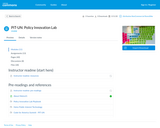
These are course materials for Heinz College's Policy Innovation Lab. Questions and / or comments about these materials should be directed to Chris Goranson (cgoranso@andrew.cmu.edu). These materials are provided in support of the PIT-UN initiative and related work.

A UTILIZAÇÃO da autopoiese para identificação e resolução dos principais problemas ambientais na comunidade quilombola do Itacoã Mirim, Baixo Acará (PA): entre as ciências ambientais, decolonidades, territorialidades e temporalidades. Direção: Aldo Luiz Viana Gatinho. Belém: Produção independente, 2022. 25’34”. O vídeo documentário é o produto educacional da dissertação de mestrado de Aldo Luiz Viana Gatinho, defendida e aprovada em 14/12/2022.

A Ação Diálogos Sustentável tem o objetivo de facilitar o diálogo construtivo entre diferentes partes envolvidas em conflitos socioambientais, promovendo a compreensão mútua, a conscientização e a busca por soluções colaborativas.

Case Study for Pain Assessment using the PQRSTU method. Identifies how to find objective and subjective cues for pain.

O caderno "Panorama dos Recursos Hídricos em Diferentes Contextos", constitui um dos produtos técnicos educacionais da dissertação intitulada "Percepções e mapeamento de conflitos socioambientais relativos à água nos limites da bacia hidrográfica do Paraguaçu. Este produto foi elaborado tomando como referência a "Enquete operária de Karl Max", apresentamos, portanto, um questionário cujo objetivo é conduzir o leitor a uma reflexão crítica a respeito da sua realidade local e sua relação com os recursos hídricos.

(This case study was added to OER Commons as one of a batch of over 700. It has relevant information which may include medical imagery, lab results, and history where relevant. A link to the final diagnosis can be found at the end of the case study for review. The first paragraph of the case study -- typically, but not always the clinical presentation -- is provided below.)
A 36-year-old man presented with a large nasal tumor following a long history of multiple meningiomas. At the age of 13, the patient underwent surgical resection and received a single course of radiation therapy for a left optic meningioma. He did well until age 33, when he was found to have multiple meningiomas in three new locations: falcine (Figure 1a), right petroclival and right anterior foramen magnum. These were surgically resected but no additional radiation was administered. Three years later, the patient presented with nasal symptoms, headaches, and seizures. Imaging studies revealed a large mass with intracranial and nasopharyngeal component measuring 4.1 x 5.4 x 6.8 cm in greatest dimensions and causing right frontal lobe compression (Figures 1b and 1c). A systemic workup, including PET CT, for other malignancies was unremarkable. A two-stage surgical resection was performed. The mass was initially biopsied by transsphenoidal endoscopic approach and then partially resected by bifrontal craniotomy, frontal sinus obliteration, en bloc ethmoidectomy, and nasal cavity resection.
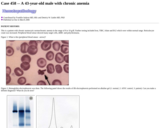
(This case study was added to OER Commons as one of a batch of over 700. It has relevant information which may include medical imagery, lab results, and history where relevant. A link to the final diagnosis can be found at the end of the case study for review. The first paragraph of the case study -- typically, but not always the clinical presentation -- is provided below.)
This is a patient with chronic normocytic normochromic anemia in the range of 8 to 10 g/dl. Further testing included Iron, TIBC, folate and B12 which were within normal range. Reticulocyte count was increased. Peripheral blood smear showed many target cells, nRBC and polychromasia.
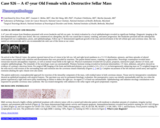
(This case study was added to OER Commons as one of a batch of over 700. It has relevant information which may include medical imagery, lab results, and history where relevant. A link to the final diagnosis can be found at the end of the case study for review. The first paragraph of the case study -- typically, but not always the clinical presentation -- is provided below.)
A 47 year old woman from Honduras presented with severe headache and left eye pain. An initial evaluation by a local ophthalmologist revealed no significant findings. Diagnostic imaging at the time demonstrated a sellar mass lesion. She was commenced on cabergoline, but this was ceased due to nausea, vomiting, and tumor progression. Her headaches persisted and she subsequently developed left eye exophthalmos, ptosis, and ophthalmoplegia. Follow-up CT demonstrated significant growth of the mass and involvement of the left orbital apex and cavernous sinus. She was started on corticosteroids and it was recommended she seek care of this lesion at our center.
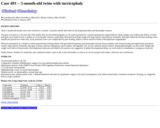
(This case study was added to OER Commons as one of a batch of over 700. It has relevant information which may include medical imagery, lab results, and history where relevant. A link to the final diagnosis can be found at the end of the case study for review. The first paragraph of the case study -- typically, but not always the clinical presentation -- is provided below.)
These 5-month-old female twins were referred to a Genetic Counselor shortly after birth for developmental delay and dysmorphic features.
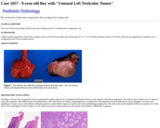
(This case study was added to OER Commons as one of a batch of over 700. It has relevant information which may include medical imagery, lab results, and history where relevant. A link to the final diagnosis can be found at the end of the case study for review. The first paragraph of the case study -- typically, but not always the clinical presentation -- is provided below.)
Nine year-old-boy presenting with left testicular swelling noticed 2-3 months prior to physician visit.
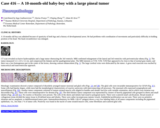
(This case study was added to OER Commons as one of a batch of over 700. It has relevant information which may include medical imagery, lab results, and history where relevant. A link to the final diagnosis can be found at the end of the case study for review. The first paragraph of the case study -- typically, but not always the clinical presentation -- is provided below.)
A 10 months old boy was admitted because of spasticity of both legs and a history of developmental arrest. He had problems with coordination of movements and particularly difficulty in holding position of his head. The head circumference was enlarged.
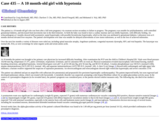
(This case study was added to OER Commons as one of a batch of over 700. It has relevant information which may include medical imagery, lab results, and history where relevant. A link to the final diagnosis can be found at the end of the case study for review. The first paragraph of the case study -- typically, but not always the clinical presentation -- is provided below.)
The patient is a 10 month-old girl who was born after a full term pregnancy via cesarean section secondary to failure to progress. The pregnancy was notable for polyhydramnios, well-controlled gestational diabetes, and decreased fetal movements late in the third trimester. At birth the baby was found to have a cardiac murmur and was mildly hypotonic, with difficulty feeding. An echocardiogram at 3 months showed mild asymmetric septal hypertrophy with possible biventricular hypertrophy, which at the time was attributed to gestational diabetes. Laboratory tests at 6 months showed elevated liver enzymes. The patient's development over time was notable for delayed achievements of new motor milestones, as well as the loss of achieved milestones.

(This case study was added to OER Commons as one of a batch of over 700. It has relevant information which may include medical imagery, lab results, and history where relevant. A link to the final diagnosis can be found at the end of the case study for review. The first paragraph of the case study -- typically, but not always the clinical presentation -- is provided below.)
The patient is a 10 year old female, active in dance classes. She is referred to rheumatology at UPMC following a week-long bout of malaise accompanied in the last several days by a pruritic lacy rash on her trunks and limbs (Figure 1). An anti-nuclear antibody (ANA) assay obtained by the outside physician at an outside laboratory was positive to a titer of 1:1,280.

(This case study was added to OER Commons as one of a batch of over 700. It has relevant information which may include medical imagery, lab results, and history where relevant. A link to the final diagnosis can be found at the end of the case study for review. The first paragraph of the case study -- typically, but not always the clinical presentation -- is provided below.)
The patient is a 10 year old female, who underwent liver transplantation at the age of 2 for Alagille syndrome-related end-stage liver disease. Prior to transplantation, she received 36 mg of thymoglobulin followed by 24 mg post transplant, and tacrolimus 2 mg twice daily. Her immediate post transplant course was complicated by a pulmonary thromboembolism and acute cellular rejection which were treated with corticosteroids and antibiotics. Approximately one year after transplant, the patient presented with flu-like symptoms that included fever, rhinorrhea, body aches and an EBV titer of 30 million copies/ml. She was admitted for ganciclovir and CytoGam administration with EBV surveillance. An abdominal CT scan demonstrated a liver lesion along with cervical and axillary adenopathy. A liver biopsy demonstrated a hepatic Epstein-Barr virus-associated smooth muscle tumor. A lymph node biopsy revealed a CD20 positive infectious mononucleosis-like post transplant lymphoproliferative disorder (PTLD). Immunosuppression was suspended, and she was treated with ganciclovir, CMV-IGIV and rituximab. Despite the reduction in immunosuppression, her liver lesions increased in size. Chemotherapy was felt to be of no additional benefit in treating the CD20 negative liver lesion. The liver lesions were monitored with scans She received 4 doses of rituximab with decrease in size of her lymph node PTLD. At the age of 8 she was no longer receiving immunosuppression and her liver masses remained stable in size by CT scan evaluation. At 10 years of age, she presented to the hospital with abdominal pain. A CBC demonstrated the following:
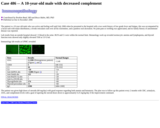
(This case study was added to OER Commons as one of a batch of over 700. It has relevant information which may include medical imagery, lab results, and history where relevant. A link to the final diagnosis can be found at the end of the case study for review. The first paragraph of the case study -- typically, but not always the clinical presentation -- is provided below.)
Lab results from an outside hospital showed +3 blood in the urine. BUN and Cr were within the normal limit. Hematology work up revealed normocytic anemia and lymphopenia, and thyroid function tests showed only slightly elevated TSH at 5.9 U/ml.